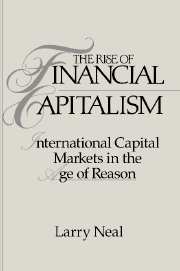Book contents
- Frontmatter
- Contents
- Acknowledgments
- 1 Historical background for the rise of financial capitalism: commercial revolution, rise of nation-states, and capital markets
- 2 The development of an information network and the international capital market of London and Amsterdam
- 3 The early capital markets of London and Amsterdam
- 4 The Banque Royale and the South Sea Company: how the bubbles began
- 5 The Bank of England and the South Sea Company: how the bubbles ended
- 6 The English and Dutch East Indies companies: how the East was won
- 7 The integration of the English and Dutch capital markets in peace and war
- 8 The English and Dutch capital markets in panics
- 9 The capital markets during revolutions, war, and peace
- 10 A tale of two revolutions: international capital flows, 1792–1815
- 11 The Amsterdam and London stock markets, 1800–25
- Appendix End-of-month share prices
- Bibliography
- Index
9 - The capital markets during revolutions, war, and peace
Published online by Cambridge University Press: 25 March 2010
- Frontmatter
- Contents
- Acknowledgments
- 1 Historical background for the rise of financial capitalism: commercial revolution, rise of nation-states, and capital markets
- 2 The development of an information network and the international capital market of London and Amsterdam
- 3 The early capital markets of London and Amsterdam
- 4 The Banque Royale and the South Sea Company: how the bubbles began
- 5 The Bank of England and the South Sea Company: how the bubbles ended
- 6 The English and Dutch East Indies companies: how the East was won
- 7 The integration of the English and Dutch capital markets in peace and war
- 8 The English and Dutch capital markets in panics
- 9 The capital markets during revolutions, war, and peace
- 10 A tale of two revolutions: international capital flows, 1792–1815
- 11 The Amsterdam and London stock markets, 1800–25
- Appendix End-of-month share prices
- Bibliography
- Index
Summary
In February 1793, after war had been declared by the French revolutionary government against both England and Spain, and the Dutch “patriot” party was attempting its own revolution in Amsterdam in sympathy, the great Anglo-Dutch merchant banker Henry Hope removed himself from Amsterdam to London. He returned briefly in December when it appeared that the first invasion of the Austrian Netherlands had been defeated. But on 17 October 1794, as French troops were poised at the River Maas for the final offensive into Holland, he crossed over to England permanently, with John Williams Hope, while other members of the firm fled to Germany. The two remaining members, Pierre Labouchere and Alexander Baring, made their escape on 18 January 1795. Henry Hope carried with him 372 valuable paintings, insured for £26,000. Without selling his recently completed country seat at Welgelegen or his warehouse and office in central Amsterdam, he arranged for purchase of the East Sheen estate near Richmond and a palatial London residence that he began to expand in order to accommodate his collection of art.
This is only one example, albeit one of the largest and best-documented examples, of the displacement of capital from the European continent in front of the advancing French Revolution and its armies. The revolutionaries had abolished traditional property rights, including feudal obligations and seigneurial dues, and they disrupted customary channels of trade. Hope and his family, already having strong financial ties with England, were able to transfer their movable wealth nearly intact.
- Type
- Chapter
- Information
- The Rise of Financial CapitalismInternational Capital Markets in the Age of Reason, pp. 180 - 200Publisher: Cambridge University PressPrint publication year: 1991



